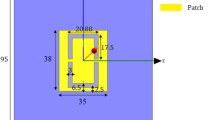Abstract
In this paper a novel design and analysis of an Antenna with broadband behavior has presented. Antenna is designed and fabricated on an inset fed Microstrip Antenna and calculate the effect of antenna dimensions Length (L), Width (W) and substrate parameters relative Dielectric constant (εr), substrate thickness (h), which will be useful in radiation parameters of calculating band width. Also discovery of CNT & Nanomaterials, it is possible to use various techniques for absorption of EMI radiations. Our main aim is to design an antenna which is capable to absorb harmful radiations and obtain a suitable material which is used for making a patch or substrate. Proposed antenna frequency bands for communication purposes which will be called the low band (2.495–2.695 GHz), the medium band (3.25–3.85 GHz) and the high band (5.25–5.85 GHz). The design of required patch antenna is simulated by using software named “IE3D v-12 simulator Zeland Inc.” and required patch antenna and its parameters can be realized as per design requirements.
Similar content being viewed by others
Keywords
1 Introduction
The simple dictionary meaning of an antenna is that it is usually metallic device (as a rod or wire) for radiating or receiving radio waves [2, 8]. The IEEE standard definitions in terms for antennas is defines the as “a means for transmitting or receiving radio waves.” In other words, the antenna is the transitional structure between free space and a guiding device [10]. The antenna is also referred to as aerial. So in simple words antenna is defined as “a transducer which convert electromagnetic waves into required electrical signal at receiver and also a metallic device used for transmitting or receiving electromagnetic waves which acts as the transition region between free spaces and guiding structure like a transmission line in order to communicate even in a longer distance.”
By using various Nanomaterials and CNTs we will fabricate a patch on which by suitable probe feed we obtain maximum bandwidth and efficiency of antenna. Also use suitable substrate on which patch is fabricated by masking and lithography process. Masking can be done by software (like Coral, Autocad) simulations. For compactness in advanced communication system, may be it wired or wireless communication, miniaturization is the basic needs. Microstrip patch antenna is most commonly used now a days for mobile applications or Wi-Fi, Wi-Max applications [9]. So antennas can be easily compatible with the application areas of embedded and fabricated antenna used in handheld wireless devices such as cellular phones, pagers etc. [4]. The telemetry and communication antennas on missiles need to be thin and conformal and are often in the form of Microstrip patch antennas. Another application is Radar communication and Satellite communication. In this communication rectangular patch is chosen for better response and ease of analysis rather than any other shapes.
2 Antenna Design
This given design having these dimensions: Ground dimension = 100 × 100. Ground cut at point (0, 50). The geometrical representation of proposed antenna [1] is shown in Fig. 1.
At patch, at axis (−25, 0), having length L = 50 mm and width W = 20 mm, cut at angle 90°. Ellipse major axis a = 30 mm, Ellipse Minor Axis b = 20 mm. ∈ r = 4.4, tangent loss = 0.025, h = 1.59.
There are few considerations or parameters for the design of a rectangular Microstrip Patch Antenna which will be taken care of: A substrate with a high dielectric constant has been selected since it reduces the dimensions of the antenna according to our application. The resonant frequency (fr) of the antenna must be selected appropriately. The Mobile Communication Systems uses the frequency range from 2 to 6 GHz. By doing this we fabricate or design an antenna which will be able to operate in the desired frequency range [5, 6]. The resonant frequency selected for my design is 3–8 GHz.
For the microstrip patch antenna to be used in cellular phones, it is essential that the antenna is not bulky. So, the dielectric substrate is selected as 1.59 mm height (h).
Hence, the essential parameters for the design are: fo = 3–8 GHz, εr = 4.4 and h = 1.59 mm.
Zeland Inc’s IE3D is the software we used to model and simulate the Microstrip patch antenna. IE3D is a full-wave electromagnetic simulator based on the method of moments. It analyzes 3D and multilayer structures of general shapes. It has been widely used in the design of MICs, RFICs, patch antennas, wire antennas, and other RF/wireless antennas [2]. It can be used to calculate and plot the S11 parameters, return losses, smith chart etc. as well as the radiation patterns (Fig. 2).
3 Result
The return loss for the patch antenna can be measured on a network Analyzer [7, 10]. The pattern created in a far field test can be shown as E-plane and H-plane patterns [13], (preferably in an anechoic chamber) calculated with a standard gain antenna as a transmitting antenna and the Antenna under test as a receiving antenna mounted on a pedestal [7]. Layout generation can be done in coral draw or autocad software for preparing the mask. Once the mask is printed on a transparent sheet, the patch can be fabricated using conventional photolithography process [10]. Once the dimensions are obtained the antenna can be simulated on a commercially available 2.5D or a 3D EM simulator [7, 10]. Further optimization and fine tuning of dimensions, other parameters like axial ratio, smith chart, 2D pattern etc. can be carried out to bring the resonance back at the desired frequency with acceptable return loss (Fig. 3).
The radiation pattern of antenna represents the radiation property of antenna as a function of space coordinates. The pattern gives the normalized field (power) value w.r.t. the maximum value [13]. In patch antenna various radiation properties include directivity, gain, power flux density, radiation intensity, radiation resistance, field strength, phase polarization. It will resonate at the frequency of 4.15 GHz, it means antenna give maximum radiation at this frequency (Fig. 4).
Impedance calculated is 36.19–2.27j, by showing these values we see that the antenna impedance is not properly matched so there is losses occur in these design. So to rectify this problem we will shift or change the probe position by proper dimension and check the result on IE3D simulator (Figs. 5 and 6).
Here we see that the antenna efficiency and radiation efficiency is 40.77 and 42.75% respectively. As we see in figure, by increase in the frequency we obtain the maximum efficiency. We generally use S band frequency range applications by this proposed design. The maximum bandwidth is 7.47 Hz at maximum resonant frequency i.e., 4.15 GHz (Fig. 7).
3.1 Simulation Setup and Results
Freq. | Return loss | Impedance | Bandwidth | Antenna efficiency | Radiation efficiency | Axial ratio (0, 90) |
|---|---|---|---|---|---|---|
4.15 | −15.81 | 36.19-2.27j | 7.47 | 40.77 | 42.75 | 15.21, 25.38 |
4 Conclusion
We propose a design and fabrication of elliptical microstrip patch antenna in this paper. Our main objective is work on the allocation of frequency bands for communication purposes which will be called the L & S band (ranging from 1 to 4 GHZ). The 2.45–2.484 and 5.15–5.825 GHz frequency bands have been adopted by IEEE 802.11a5 for wireless local area networks (WLAN) [13]. The maximum absorption value will be achieved by designing that antenna with the composition of nanomaterial as base, maximum absorption ratio will be achieved. The study explicitly showed that the nanomaterial or CNT [11] with patch material i.e., copper, this compound show possibility of EMI shielding for various applications up to X band frequency range [12]. So by using this design in elliptical microstrip patch antenna we find various results by changing the position of probe at same ground cut, patch cut etc. Without ground cut we obtain better gain but poor bandwidth. As we change probes in a constant ground cut, its bandwidth and efficiency is improved.
References
Kushwah, V.S., Tomar, G.S.: Size reduction of microstrip patch antenna using defected microstrip structures. In: 2011 International Conference on Communication Systems and Network Technologies. https://doi.org/10.1109/CSNT.2011.50. 978-0-7695-4437-3/11/$26.00 ©2011 IEEE
Pu, W., Xiao-Miao, Z., Zhen-Lin, L.: A novel elliptical UWB antenna with dual band-notched characteristics. 978-1-4244-8443-0/11/$26.00 ©2011 IEEE
Nath, M., Chakravarty, T., De, A.: An experimental study on the resonant frequency of shorted elliptical patch. 1-4244-0123-2/06/$20.00 ©2006 IEEE
Sharma, V., Saxena, V.K., Sharma, K.B., Saini, J.S., Bhatnagar, D.: Probe feed elliptical patch antenna with slits for WLAN application. In: Proceedings of International Conference on Microwave–08. 978-1-4244-2690-4444/08/$25.00 ©2008 IEEE
Bhattacharyya, A.K., Shafai, L.: Elliptical ring patch antenna for circular polarization. CH2563-5/88/0000-0022$1.00 ©1988 IEEE
Bhattacharyya, A.K.: Effects of ground plane truncation on the impedance of a patch antenna. In: IEEE Proceedings-II, vol. 138(6) December 1991
Behdad, N.: Simulation of a 2.4 GHz patch antenna using IE3D. EEL 6463, Spring 2007
Garg, R., Bhartia, P.: Microstrip Antenna Design Handbook. Antennas and Propagation Library. Artech House, London
Balanis, C.A.: Antenna Theory - Analysis and Design, 3rd edn.
Singh, S.P., Singh, A., Upadhyay, D.: Design and fabrication of microstrip patch antenna at 2.4 GHz for WLAN application using HFSS. IOSR J. Electron. Commun. Eng. (IOSR-JECE). e-ISSN: 2278-2834, p-ISSN: 2278-873, Special Issue-AETM’16
Caudillo, R., Troiani, H.E., Miki-Yoshida, M., Marques, M.A.L., Rubio, A., Yacaman, M.J.: A viable way to tailor carbon nanomaterials by irradiation-induced transformations. Radiat. Phys. Chem. 73, 334–339 (2005). 0969-806X ©2004 Elsevier Ltd
Reshi, H.A., Singh, A.P., Pillai, S., Para, T.A., Dhawan, S.K., Shelke, V.: X Band frequency response and electromagnetic interference shielding in multiferroic BiFeO3 nanomaterials. Appl. Phys. Lett. 109, 142904 (2016). AIP publishing
Dong, J., Wang, A., Wang, P., Hou, Y.: A novel stacked wideband microstrip patch antenna with U-shaped parasitic elements. 978-1-4244-2193-0/08/$25.00 ©2008 IEEE
Author information
Authors and Affiliations
Corresponding author
Editor information
Editors and Affiliations
Rights and permissions
Copyright information
© 2019 Springer Nature Switzerland AG
About this paper
Cite this paper
Heer, M.S., Sharma, V. (2019). An Empirical Approach on Absorption of EMI Radiations by Designing Elliptical Microstrip Patch Antenna. In: Benavente-Peces, C., Slama, S., Zafar, B. (eds) Proceedings of the 1st International Conference on Smart Innovation, Ergonomics and Applied Human Factors (SEAHF). SEAHF 2019. Smart Innovation, Systems and Technologies, vol 150. Springer, Cham. https://doi.org/10.1007/978-3-030-22964-1_4
Download citation
DOI: https://doi.org/10.1007/978-3-030-22964-1_4
Published:
Publisher Name: Springer, Cham
Print ISBN: 978-3-030-22963-4
Online ISBN: 978-3-030-22964-1
eBook Packages: Intelligent Technologies and RoboticsIntelligent Technologies and Robotics (R0)











